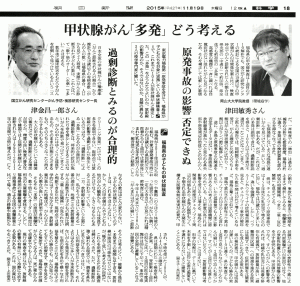Original Japanese written by staffer
The English below translated from the original Japanese by Heeday
The English translation edited by Rev. Dr. Henry French, ELCA
(Based on an article from the November 19th, 2015 edition of the Asahi Shimbun newspaper)
▼Click the image to read the caption.
–Thyroid cancer found in “many” children—or not–
Opinions by
Prof. Toshihide Tsuda, environmental epidemiology, Okayama University Graduate school of Medicine
Mr. Shoichiro Tsugane, Director, Research Center for Cancer Prevention and Screening, National Cancer Center
Following the meltdown of the Fukushima Daiichi Nuclear Power Plant (NPP), the Fukushima Prefectural Government has been conducting thyroid examinations of children. The examinations have so far determined that 104 children examined have thyroid cancer. Are those “many” cases of the cancer ascribable to radiation, or not? Here, two epidemiology experts with contradictory opinions describe their respective viewpoints.
・Toshihide Tsuda, environmental epidemiology, Okayama University Graduate School of Medicine
Some people claim that those thyroid examinations have resulted in some “over-diagnosis, which counts very slowly growing cancer that will actually never fully develop during the lifetime of the patient.” Yet the claim of “over-diagnosis” would imply that an unnecessary thyroid cancer operation has been conducted in more than a hundred children. In fact, however, a report by Fukushima Medical University shows that, in some 40% of those 96 children confirmed to have thyroid cancer and who were operated on at the University’s hospital, the cancer had spread outside the thyroid. In more than 70% of them, the cancer had metastasized to lymph nodes.
Also, Fukushima Prefecture and the northern Kanto Region have population densities several times greater than that of Chernobyl, which explains why exposure to low-level radiation has caused this many cases of thyroid cancer.
A major outbreak of thyroid cancer cases is expected. We need to prepare the health care system to face it. Pregnant women and infants can rest in, or move to, somewhere with much lower levels of radiation. Any policy must be postponed that intends to bring evacuees back into the “specified evacuation zones.” Also, we need to survey cancer cases in the northern Kanto Region as well.
The role science has to play, in this particular case, is to predict what can happen in the future based on data available and suggest what measures should be taken for the sake of the affected residents, before it is too late.
- Shoichiro Tsugane, Director, Research Center for Cancer Prevention and Screening, National Cancer Center
At this moment, it is rational to ascribe those “many” cases to “over-diagnosis.”
Since over-diagnosis seems quite probable, thyroid examinations should not spread beyond Fukushima Prefecture. Such expanded examinations might save one patient, while many more would be diagnosed as having cancer that would actually be difficult to diagnose otherwise. Then, if many such people were given cancer treatments, they would experience many disadvantages, including changes to their lifestyles. In case of Fukushima’s children with detected cancer, we should consider the option of wait-and-see. Less than one patient under 40 years of age dies of thyroid cancer in Fukushima Prefecture, according to the mortality ratios there.
We need to continue the current examinations and rationally analyze influences from radiation. This is something the national government should do.
(Opinion of the staffer writing this.)
I live in Koriyama City, Fukushima Prefecture, where we still have many “hot spots,” here and there—small places with high radiation doses—more than four years after the meltdown began. We who live here are unable to completely avoid exposure to low radiation doses.
Living in a place like this, I am seriously worried that the national government will delay implementation of countermeasures by postponing its admission that the many cases of child thyroid cancer here are ascribable to exposure to radiation,. Such a delay can lead to more children falling victims to radiation-caused diseases.
Of course, the diagnosis and treatment of child thyroid cancer should be conducted carefully. At the same time, the national government needs to take more measures both to help people avoid more radiation exposure and to facilitate care to people already exposed.
In the year of the Chernobyl disaster, the number of cases of child thyroid cancer expanded in number. Medical doctors there told the whole world about this. The IAEA’s survey of 1990 to 1991, however, denied that there were “many” such incidents, saying that surveys in Hiroshima and Nagasaki showed that more than a decade is necessary for child thyroid cancer to develop. Thus, it was more than a decade after the disaster, before they admitted many occurrences of such cancer. This attitude of the IAEA drastically reduced the amount of help offered to Chernobyl from the rest of the world.
Belarus has nine recuperation facilities aided by its national government. They are meant to enhance the immunity of those children exposed to radiation and help such children remove radioactive substances from their bodies. Many are still in recuperation at those facilities, and the effects of recuperation are obvious in almost all of those children, according to reports. I believe Japan’s government should also learn from those examples and come up with government-funded recuperation programs.
We adults are responsible for our children’s health. We should not let radiation exposure cast dark shadows over the futures of such children. I do believe, therefore, that we adults have to take any measures we can to protect such children.
